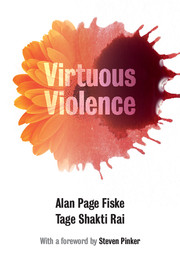Book contents
- Frontmatter
- Dedication
- Contents
- Figures and tables
- Foreword
- Warm thanks
- The point
- 1 Why are people violent?
- 2 Violence is morally motivated to regulate social relationships
- 3 Defense, punishment, and vengeance
- 4 The right and obligation of parents, police, kings, and gods to violently enforce their authority
- 5 Contests of violence: fighting for respect and solidarity
- 6 Honor and shame
- 7 War
- 8 Violence to obey, honor, and connect with the gods
- 9 On relational morality: what are its boundaries, what guides it, and how is it computed?
- 10 The prevailing wisdom
- 11 Intimate partner violence
- 12 Rape
- 13 Making them one with us: initiation, clitoridectomy, infibulation, circumcision, and castration
- 14 Torture
- 15 Homicide: he had it coming
- 16 Ethnic violence and genocide
- Chapter 17 Self-harm and suicide
- 18 Violent bereavement
- 19 Non-bodily violence: robbery
- 20 The specific form of violence for constituting each relational model
- 21 Why do people use violence to constitute their social relationships, rather than using some other medium?
- 22 Metarelational models that inhibit or provide alternatives to violence
- 23 How do we end violence?
- 24 Evolutionary, philosophical, legal, psychological, and research implications
- The dénouement
- References
- Index
The dénouement
Published online by Cambridge University Press: 05 December 2014
- Frontmatter
- Dedication
- Contents
- Figures and tables
- Foreword
- Warm thanks
- The point
- 1 Why are people violent?
- 2 Violence is morally motivated to regulate social relationships
- 3 Defense, punishment, and vengeance
- 4 The right and obligation of parents, police, kings, and gods to violently enforce their authority
- 5 Contests of violence: fighting for respect and solidarity
- 6 Honor and shame
- 7 War
- 8 Violence to obey, honor, and connect with the gods
- 9 On relational morality: what are its boundaries, what guides it, and how is it computed?
- 10 The prevailing wisdom
- 11 Intimate partner violence
- 12 Rape
- 13 Making them one with us: initiation, clitoridectomy, infibulation, circumcision, and castration
- 14 Torture
- 15 Homicide: he had it coming
- 16 Ethnic violence and genocide
- Chapter 17 Self-harm and suicide
- 18 Violent bereavement
- 19 Non-bodily violence: robbery
- 20 The specific form of violence for constituting each relational model
- 21 Why do people use violence to constitute their social relationships, rather than using some other medium?
- 22 Metarelational models that inhibit or provide alternatives to violence
- 23 How do we end violence?
- 24 Evolutionary, philosophical, legal, psychological, and research implications
- The dénouement
- References
- Index
Summary
What do we mean by “most” violence?
Reviewing a multitude of literatures, we’ve been impressed by how much violence seems to be morally motivated. But given the available data, there is no way to quantify the proportion of violence, or the proportion of specific forms of violence, such as homicide, that are morally motivated to regulate social relationships. Some violence is just coercive force instrumentally used in pursuit of non-social aims. As we’ve discussed, psychopaths commit a significant proportion of the violence that is not morally motivated, though there are few data to indicate what that proportion is. However, we can greatly advance our understanding of violence without waiting for an answer. Newton didn’t show what proportion of the motion of objects his laws explained, and a general answer isn’t very meaningful, in any case. To describe and predict the motion of objects, we know that friction has to be taken into account in certain cases, but in many cases can be ignored for all practical purposes. Newton’s laws are poor descriptions of motions at relativistic velocities or on quantum dimensions, they make the false, simplifying assumption that objects are points in space, and they can’t provide exact analytic solutions for the motions of three or more bodies. Still, Newton’s three laws of motion are extremely general and useful, elegantly describing a huge range of dynamic systems. Likewise, virtuous violence theory makes simplifying assumptions and may not explain violence under the most extreme conditions. But we believe that our theory parsimoniously and clearly describes most violence under most ordinary conditions in all cultures throughout history and prehistory. There are other, non-moral motives for violence. But until we account for the major mechanism, we can’t identify the minor ones, can’t understand the conditions under which each source operates, and can’t figure out how different sources of violence interact. Until Darwin described natural selection, it wasn’t possible to identify or delineate sexual selection, genetic drift, population-isolation factors, and other mechanisms of evolution. Likewise, without acknowledging that the prevalent forms of violence are morally motivated and culturally legitimated, we will never adequately understand differences in propensities for violence across cultures, among individuals, across the life span, or between genders.
- Type
- Chapter
- Information
- Virtuous ViolenceHurting and Killing to Create, Sustain, End, and Honor Social Relationships, pp. 301 - 304Publisher: Cambridge University PressPrint publication year: 2014

